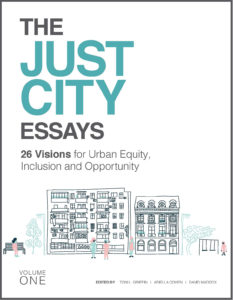“Five years ago, the Harvard Graduate School of Design’s Just City Lab published The Just City Essays: 26 Visions of Inclusion, Equity and Opportunity. The questions it posed were deceptively simple: What would a just city look like? And what could be the strategies to get there? These questions were posed to mayors, architects, artists, philanthropists, educators and journalists in 22 cities, who told stories of global injustice and their dreams for reparative and restorative justice in the city.
 These essays were meant as a provocation, a call to action. Now, during these times of dissonance, unrest, and uncertainty, their contents have become ever more important. For the next 26 weeks, the GSD and the Just City Lab will republish one essay a week here and at designforthejustcity.org. We hope they may continue conversations of our shared responsibility for the just city.
These essays were meant as a provocation, a call to action. Now, during these times of dissonance, unrest, and uncertainty, their contents have become ever more important. For the next 26 weeks, the GSD and the Just City Lab will republish one essay a week here and at designforthejustcity.org. We hope they may continue conversations of our shared responsibility for the just city.
We believe design can repair injustice. We believe design must restore justice, especially that produced by its own hand. We believe in justice for Black Americans. We believe in justice for all marginalized people. We believe in a Just City.”
—Toni L. Griffin, Professor in Practice of Urban Planning, founder of the Just City Lab, and editor of The Just City Essays
Cape Town Pride; Cape Town Shame
By Carla Sutherland
I have lived in an array of fascinating cities, and visited a host of others. I have loved many (New York, Hong Kong, Harare and Berlin); been miserable in a few (London and Pretoria); oddly disappointed by some (San Francisco, Dublin and Sydney); overwhelmed by others (Shanghai and Cairo); and frankly terrified by at least two (Port Moresby and Lagos).
But there’s only one city I have ever really called home: Cape Town. When asked where I am from, I never say “South Africa,” always just “Cape Town.” Despite the fact that I have not lived there for the past 15 years, it remains my cultural and geographical touchstone. Last year, the New York Times and the Sunday Telegraph both named Cape Town as the most desirable city in the world to visit:
You can go almost anywhere to experience the city’s in-your-face beauty— adrenaline junkies plunge into the marine-rich waters around Dyer Island to go nose-to-nose with Great Whites; shoppers scour Woodstock for the latest in Afro-chic design, then quench their thirst with local craft beer; foodies are spoilt for choice in valleys carpeted with vines, where worldclass chefs prepare Michelin-rated fare at bargain prices.¹
And much of that is true. Each time I return to Cape Town, I think to myself, “it can’t be as beautiful as I remember.” But when I sweep over the curve of Mandela Boulevard, and begin the descent to the City Bowl, I always catch my breath in wonder. On the left, Table Mountain with a rolling white table-cloth of cloud; the pink evening sea-skyline broken only by the umbrella cranes of the harbor on the right; and our brooding Lion’s Head on Signal Hill peering down over the multicolored houses of Bo-Kaap and District Six.
Sadly though, my home-city, like many a family home, is deeply dysfunctional. Putting on its Sunday best for visitors, it works hard to sweep undesirable realities under the carpet. In particular, this means hiding family members who can’t (or won’t) be part of its pretty façade, behind closed doors. Continue reading on designforthejustcity.org…
